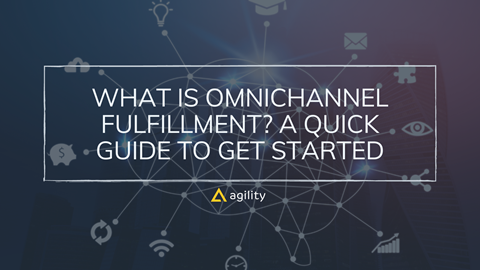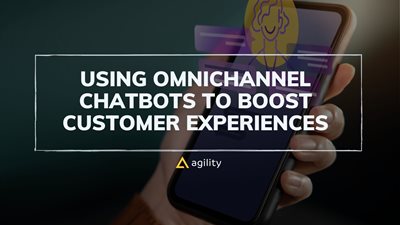What Is Omnichannel Fulfillment? A Quick Guide to Get Started


In the new normal of eCommerce, customers demand a seamless experience across channels and devices. Today, customers want to browse products online, find the ones they like, and buy them from one retailer.
They want to confirm their orders immediately after placing them, get tracking information when their shipment has been shipped and delivered, and return items if they don’t fit or don’t like them.
If you haven’t already considered it as part of your eCommerce strategy this year, omnichannel fulfillment is something you will want to seriously think about now.
As with any operation that involves so many moving pieces, implementing an omnichannel fulfillment strategy can seem overwhelming at first glance.
But with the right planning and implementation — plus plenty of testing along the way — you can make things much easier on yourself in the long run. Read on for everything you need to know about what omnichannel fulfillment is, whether it is right for your business, benefits, challenges, and actionable practices to improve omnichannel fulfillment.
What Is Omnichannel Fulfillment?
Omnichannel fulfillment is the process of managing and executing orders from multiple sales channels through a single inventory system.
It gives businesses the ability to track inventory in real-time and route orders to the closest fulfillment location — whether that’s a brick-and-mortar store, a distribution center, or even the customer’s home.
Omnichannel fulfillment also allows businesses to offer customers more delivery and pickup options, which can lead to higher satisfaction rates.
When a customer places an order on your website for pickup in-store, the nearest location with the inventory to fulfill that order is automatically identified, and the order is routed accordingly.
For example, if you own a clothing store and a customer orders a dress online for in-store pickup, the order would be routed to the store location that has that dress in stock.
If you don’t have the inventory to fulfill the order at any of your store locations, the order can be fulfilled from your distribution center.
Basic Omnichannel Fulfillment Process
Here are the four basic processes of omnichannel fulfillment:
Omnichannel interaction. This is where you build a strong connection and interaction with your customer base through all channels through content– from your landing pages to your TikTok marketing account or by utilizing the exploding popularity of SMS marketing which you can send push notifications and bulk messages direct to your costumers. You need to be able to identify customer needs, wants, and expectations across channels, and then create a strategy to address them.
Ordering and confirmation. When a customer places an order on one of your channels, you need to be able to confirm the order and route it to the appropriate fulfillment location in real time. For easier work with orders, especially, if you’re a total beginner, you’d better use one of these efficient eCommerce shopping cart platforms.
Warehouse management. This process involves tracking inventory levels in real time across all channels and locations. It’s important to have a robust inventory management system in place so you can ensure that you have the right products in stock to meet customer demand.
Shipping and delivery. Once you’ve confirmed an order and routed it to the appropriate fulfillment location, you need to make sure the products are shipped out in a timely manner and delivered to the customer as expected.
Omnichannel Fulfillment vs. Multichannel Fulfillment
Omnichannel fulfillment is often confused with multichannel fulfillment, but there is a big difference between the two.
With multichannel fulfillment, businesses manage inventory separately for each sales channel.
So, if you have a brick-and-mortar store and an eCommerce website, you would likely have two separate inventory systems — one for each channel.
In contrast, omnichannel fulfillment uses a single inventory system to manage inventory across all channels. This allows businesses to have a real-time view of their inventory levels at all times, no matter where the inventory is located.
Is Omnichannel Fulfillment Right for My Business?
Omnichannel fulfillment is not a one-size-fits-all solution — it’s important to consider whether or not it’s right for your business before making the switch.
Here are a few things to keep in mind:
Do you have the resources to manage a single inventory system?
If you’re already struggling to keep up with multiple inventory systems, adding another one is likely to only make things worse.
Before making the switch to omnichannel fulfillment, consider whether or not you have the staff and budget to manage a single inventory system.
What are your long-term growth plans?
If you’re planning to expand your business to multiple channels in the near future, omnichannel fulfillment will make it easier to do so.
But if you’re happy with your current setup and don’t have plans to expand, there’s no need to switch to a new system.
What are your customers’ needs?
Omnichannel fulfillment is all about giving customers what they want when they want it. If your customers are happy with your current fulfillment setup, there’s no need to change things.
But if you’re getting a lot of complaints about long shipping times or out-of-stock items, omnichannel fulfillment could be the answer.
Benefits of Omnichannel Fulfillment
Now that we’ve answered the question, “What is omnichannel fulfillment?” it’s time to take a look at the benefits of this type of fulfillment.
Boost Customer Satisfaction
In this fast-paced market world with the busiest people, customers want their orders faster than ever — and they’re willing to pay for them.
Omnichannel fulfillment gives businesses the ability to offer customers multiple shipping and delivery options, which can lead to higher satisfaction rates.
A customer can place an order on your website and choose to pick it up in-store, have it delivered to their home, or even send it to a different location altogether.
This flexibility is not only convenient for customers, but it also gives them the peace of mind of knowing that they can get their order when and where they want it.
By offering customers multiple shipping and delivery options, you’ll be able to keep them happy and coming back for more.
Better Inventory Management
One of the biggest benefits of omnichannel fulfillment is that it gives businesses a real-time view of their inventory levels.
With a single inventory system, businesses can see exactly how much inventory they have at all times, no matter where it’s located. This way, it's easier to improve order accuracy.
This is a huge advantage over multichannel fulfillment, where businesses have to keep track of multiple inventory templates and systems.
With omnichannel fulfillment, businesses can avoid overstocking or running out of inventory altogether. They can also take advantage of opportunities to upsell and cross-sell customers on other products they may be interested in.
Lower Shipping Costs
Omnichannel fulfillment can also help businesses save money on shipping costs.
Because businesses have a real-time view of their inventory levels, they can ship orders from the location that’s closest to the customer.
This cuts down on shipping time and costs and reduces the chances of orders getting lost in transit.
Besides, with omnichannel fulfillment, businesses can save money on packaging costs. When businesses know exactly what inventory they have on hand, they can avoid over-ordering packaging materials.
Increase Flexibility
With omnichannel fulfillment, businesses have the flexibility to route orders to the nearest fulfillment location, whether that’s a brick-and-mortar store, a distribution center, or even a third-party fulfillment center.
This increased flexibility gives businesses the ability to scale their operations quickly and efficiently, without having to build new infrastructure.
It also allows businesses to take advantage of seasonal spikes in demand by routing orders to locations that have the inventory to meet the demand.
Challenges of Omnichannel Fulfillment
Besides all those benefits, omnichannel fulfillment isn't plain sailing. Here are some challenges that businesses need to be aware of.
Here are why omnichannel fulfillment can be quite difficult for some businesses to implement.
Keeping Track of Inventory Levels
With omnichannel fulfillment, businesses need to have a real-time view of their inventory levels at all times. This way, they can avoid overstocking or running out of inventory altogether.
It can be challenging for businesses to track their inventory levels in real-time, especially if they have inventory spread out across multiple locations.
Knowing which items to keep in stock and which items to backorder can be another challenge, too.
If a business keeps too much inventory on hand, it’ll be stuck with excess inventory that it can’t sell. On the other hand, if a business doesn’t keep enough inventory on hand, they risk running out of stock and losing sales.
Shipping and Fulfillment
Another challenge that businesses need to be aware of is shipping and fulfillment.
With omnichannel fulfillment, businesses need to ship orders from the location that’s closest to the customer. This can be a challenge, especially if businesses have inventory spread out across multiple locations.
Omnichannel fulfillment can also be a challenge for businesses that are used to fulfilling orders through a single channel.
If businesses are used to fulfilling orders through a single channel, they’ll need to make sure their inventory management and shipping procedures are up to par before they implement an omnichannel fulfillment strategy.
Constantly Engaging With Customer Interactions
Another challenge that businesses need to be aware of is customer interaction.
With omnichannel fulfillment, businesses need to provide their customers with a consistent experience across all channels. The steady streams of content, updates, customer inquiries, encouraging user-generated content and everything from all channels– from website to social media need to be managed.
Agility CMS can help you with omnichannel content. This headless CMS allows you to create the best content for each channel without being heavily reliant on the developers and IT department.
Actionable Practices for Successful Omnichannel Fulfillment
In order to be successful with omnichannel fulfillment, businesses need to put the following practices into action.
Establish a Well-Rounded Inventory Management
One of the most important things businesses can do to be successful with omnichannel fulfillment is to have a real-time view of their inventory levels at all times.
This way, businesses can avoid overstocking or running out of inventory altogether.
It’s also important for businesses to know which items to keep in stock and which items to backorder.
If a business keeps too much inventory on hand, it’ll be stuck with excess inventory that it can’t sell. On the other hand, if a business doesn’t keep enough inventory on hand, they risk running out of stock and losing sales.
The best way to manage inventory levels is to have a central database that all employees can access. This way, everyone will be on the same page when it comes to inventory levels.
Another way to manage inventory levels is to use a software system that can track inventory levels in real time.
Use Fulfillment Centers That Are Close to Customers
Another important thing businesses can do to succeed with omnichannel fulfillment is to use fulfillment centers close to their customers.
This way, businesses can ship orders from the location that’s closest to the customer. This can save businesses a lot of time and money, especially if they have inventory spread out across multiple locations.
It’s also important for businesses to make sure that their fulfillment centers are able to handle the volume of orders they’re receiving.
If businesses use fulfillment centers that can’t handle the volume of orders they’re receiving, they risk running into shipping and fulfillment issues.
Implement a Shipping Strategy That Meets Customers’ Expectations
Another important thing businesses can do to be successful with omnichannel fulfillment is to implement a shipping strategy that meets customers’ expectations.
Customers today expect orders to be shipped quickly and efficiently. If businesses don’t ship orders quickly, they risk losing sales.
It’s essential for businesses to offer multiple shipping options to their customers. Customers should be able to choose from a variety of shipping methods, such as expedited shipping, standard shipping, and local pickup. This way, customers can choose the shipping method that best meets their needs.
It’s also important to provide them with tracking information. Customers should be able to track their orders from when they place them until they receive them.
Over to You
Omnichannel fulfillment is a must for retail businesses that want to give today's customers what they crave: convenience, choice, and a personalized experience.
But with the challenges that come along with it, businesses need to be strategic in their approach to omnichannel fulfillment.
By implementing the practices we’ve discussed, businesses can provide their customers with a consistent experience across all channels and keep track of customer interactions. Of course, all these require a ton of work and dedication, but the payout is ultimately worth it.

About the Author
Andre Oentoro is the founder of Breadnbeyond, an award-winning explainer video company. He helps businesses increase conversion rates, close more sales, and get positive ROI from explainer videos (in that order).
Twitter: @breadnbeyond
Email: andre@breadnbeyond.com
LinkedIn: Andre Oentoro
View Related Resources

Omnichannel Customer Experience: What, Where, and How

Using Omnichannel Chatbots to Boost Customer Experiences

5 Key Elements of a Successful Omnichannel Experience
Omnichannel content hub
Use Agility CMS as a single point of truth for all your content. Create, manage, relate, and collaborate within your Content Hub while sending your content anywhere, anytime. Centralize your content and build a consistent brand presence across all your channels.
Learn More